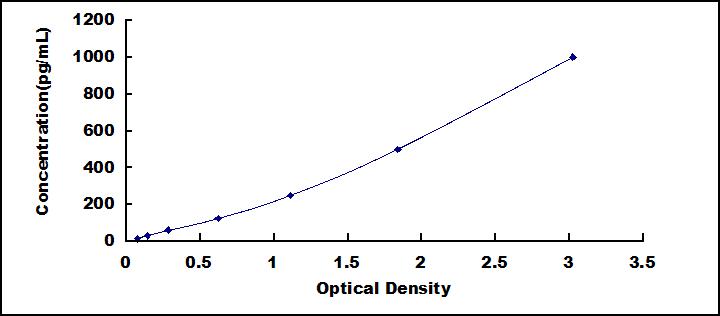Packages (Simulation)

Reagent Preparation

Image (I)
Image (II)
Certificate


ELISA Kit for Transforming Growth Factor Alpha (TGFa)
ETGF; TGF-A; Protransforming Growth Factor alpha; EGF-Like TGF
- Product No.SEA123Hu
- Organism SpeciesHomo sapiens (Human) Same name, Different species.
- Sample TypeSerum, plasma, tissue homogenates, cell lysates, cell culture supernates and other biological fluids
- Test MethodDouble-antibody Sandwich
- Assay Length3h
- Detection Range15.6-1,000pg/mL
- SensitivityThe minimum detectable dose of this kit is typically less than 5.8pg/mL.
- DownloadInstruction Manual
- UOM 48T96T 96T*5 96T*10 96T*100
- FOB
US$ 342
US$ 488
US$ 2196
US$ 4148
US$ 34160
For more details, please contact local distributors!
Specificity
This assay has high sensitivity and excellent specificity for detection of Transforming Growth Factor Alpha (TGFa).
No significant cross-reactivity or interference between Transforming Growth Factor Alpha (TGFa) and analogues was observed.
Recovery
Matrices listed below were spiked with certain level of recombinant Transforming Growth Factor Alpha (TGFa) and the recovery rates were calculated by comparing the measured value to the expected amount of Transforming Growth Factor Alpha (TGFa) in samples.
| Matrix | Recovery range (%) | Average(%) |
| serum(n=5) | 82-96 | 92 |
| EDTA plasma(n=5) | 83-99 | 95 |
| heparin plasma(n=5) | 82-95 | 88 |
Precision
Intra-assay Precision (Precision within an assay): 3 samples with low, middle and high level Transforming Growth Factor Alpha (TGFa) were tested 20 times on one plate, respectively.
Inter-assay Precision (Precision between assays): 3 samples with low, middle and high level Transforming Growth Factor Alpha (TGFa) were tested on 3 different plates, 8 replicates in each plate.
CV(%) = SD/meanX100
Intra-Assay: CV<10%
Inter-Assay: CV<12%
Linearity
The linearity of the kit was assayed by testing samples spiked with appropriate concentration of Transforming Growth Factor Alpha (TGFa) and their serial dilutions. The results were demonstrated by the percentage of calculated concentration to the expected.
| Sample | 1:2 | 1:4 | 1:8 | 1:16 |
| serum(n=5) | 80-101% | 81-94% | 89-97% | 98-105% |
| EDTA plasma(n=5) | 92-101% | 89-96% | 80-92% | 89-102% |
| heparin plasma(n=5) | 92-99% | 95-105% | 92-103% | 97-104% |
Stability
The stability of kit is determined by the loss rate of activity. The loss rate of this kit is less than 5% within the expiration date under appropriate storage condition.
To minimize extra influence on the performance, operation procedures and lab conditions, especially room temperature, air humidity, incubator temperature should be strictly controlled. It is also strongly suggested that the whole assay is performed by the same operator from the beginning to the end.
Reagents and materials provided
| Reagents | Quantity | Reagents | Quantity |
| Pre-coated, ready to use 96-well strip plate | 1 | Plate sealer for 96 wells | 4 |
| Standard | 2 | Standard Diluent | 1×20mL |
| Detection Reagent A | 1×120µL | Assay Diluent A | 1×12mL |
| Detection Reagent B | 1×120µL | Assay Diluent B | 1×12mL |
| TMB Substrate | 1×9mL | Stop Solution | 1×6mL |
| Wash Buffer (30 × concentrate) | 1×20mL | Instruction manual | 1 |
Assay procedure summary
1. Prepare all reagents, samples and standards;
2. Add 100µL standard or sample to each well. Incubate 1 hours at 37°C;
3. Aspirate and add 100µL prepared Detection Reagent A. Incubate 1 hour at 37°C;
4. Aspirate and wash 3 times;
5. Add 100µL prepared Detection Reagent B. Incubate 30 minutes at 37°C;
6. Aspirate and wash 5 times;
7. Add 90µL Substrate Solution. Incubate 10-20 minutes at 37°C;
8. Add 50µL Stop Solution. Read at 450nm immediately.
GIVEAWAYS
INCREMENT SERVICES
-
 Single-component Reagents of Assay Kit
Single-component Reagents of Assay Kit
-
 Lysis Buffer Specific for ELISA / CLIA
Lysis Buffer Specific for ELISA / CLIA
-
 Quality Control of Kit
Quality Control of Kit
-
 ELISA Kit Customized Service
ELISA Kit Customized Service
-
 Disease Model Customized Service
Disease Model Customized Service
-
 Serums Customized Service
Serums Customized Service
-
 TGFB1 Activation Reagent
TGFB1 Activation Reagent
-
 Real Time PCR Experimental Service
Real Time PCR Experimental Service
-
 Streptavidin
Streptavidin
-
 Fast blue Protein Stain solution
Fast blue Protein Stain solution
-
 Single-component Reagents of FLIA Kit
Single-component Reagents of FLIA Kit
-
 Streptavidin-Agarose Beads
Streptavidin-Agarose Beads
| Magazine | Citations |
| Journal of Physiology and Biochemistry | Protective effects of curcumin, α-lipoic acid, and N-acetylcysteine against carbon tetrachloride-induced liver fibrosis in rats SpringerLink: h875w73171w2147w |
| Oncology Reports | A bone-seeking clone exhibits different biological properties from the ACHN parental human renal cell carcinoma in vivo and in vitro PubMed: PMC3583590 |
| Sci Total Environ. | The effects of particulate matter on inflammation of respiratory system: Differences betweenmale and female. pubmed:28174048 |
| International Journal of Biological Sciences | CD9 regulates keratinocyte migration by negatively modulating the sheddase activity of ADAM17 |
| JOURNAL OF CELLULAR AND MOLECULAR MEDICINE | Polarization of ADAM17‐driven EGFR signalling in electric field‐guided collective migration of epidermal sheets Pubmed: 33164313 |
| Toll-like receptor 5-mediated signaling enhances liver regeneration in mice |






